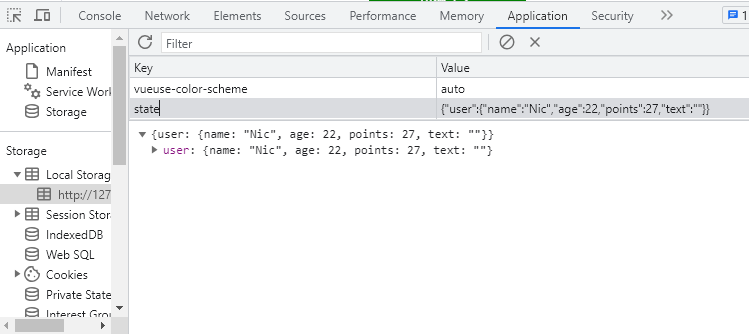Appearance
Pinia入门🍍
这篇文章的基础用法写的不错: https://blog.csdn.net/weixin_46873254/article/details/123304854
pinia官方文档: https://pinia.vuejs.org/zh/getting-started.html
1. 安装
按照文档的步骤安装,不再赘述。
pinia比起vuex,去掉了被认为是冗余的mutation, 保留 state, getter 和 action。
这三个部分类似于vue中的 data, computed 和 method.
2. 创建store
2.1 main.ts 中创建实例
可以直接在main创建实例:
ts
import { createApp } from "vue";
import App from "./App.vue";
// 引入pinia
import { createPinia } from "pinia";
// 创建 Pinia 实例
const pinia = createPinia();
const app = createApp(App);
// 挂载到 Vue 根实例
app.use(pinia);
app.mount("#app");2.2 独立文件夹管理store
也可以在自定义文件下创建实例,再挂载到App:
首先,在src下创建store文件夹以及index.ts:
ts
import { createPinia } from "pinia"; // 创建
const store = createPinia()
export { store } // 导出然后挂载到main.ts:
ts
import { createApp } from "vue";
import App from "./App.vue";
import { store } from './pinia' // 引用刚刚创建的store实例
const app = createApp(App);
app.use(store); // 使用
app.mount("#app");接着在src/store/下创建文件夹module, 然后就可以写具体的子容器,如创建一个user.ts,全局存放用户相关的data:
ts
/**
* 一般在容器中做这4件事
* 1. 定义容器并导出
* 2. 使用容器中的state
* 3. 修改容器中的state
* 4. 使用容器中的action
*/
import { defineStore } from "pinia";
/**
* 1. 定义容器并导出
* 参数一: 容器ID, 唯一, 将来 Pinia 会把所有的容器挂载到根容器
* 参数二: 选项对象
* 返回值: 函数, 调用的时候要空参调用, 返回容器实例
*/
export const useUserStore = defineStore('user', {
/**
* 类似组件的 data, 用于存储全局的的状态
* 注意:
* 1.必须是函数, 为了在服务端渲染的时候避免交叉请求导致的数据交叉污染
* 2.必须是箭头函数, 为了更好的 TS 类型推导
*/
state: () => {
return {
name: 'Nic',
age: 22,
points: 0,
text:''
}
},
/**
* 类似组件的 computed, 用来封装计算属性, 具有缓存特性
*/
getters: {
pointsAddTen(state) {
return state.points +10
}
},
/**
* 类似组件的 methods, 封装业务逻辑, 修改state
* 注意: 里面的函数不能定义成箭头函数(函数体中会用到this)
*/
actions: {
increment(num: number) {
this.points+= num
const p = this.points
switch (true) {
case p >= 100 && p < 400:
this.text = '功德小增!'
break;
case p >= 400 && p < 800:
this.text = '功德满满!'
break;
case p >= 800 && p < 1000:
this.text = '功德上乘!'
break;
case p >=1000:
this.text = '功德圆满!'
break;
default:
break;
}
},
}
})创建好,就可以调用了
3. 调用
3.1 简单调用
js
<script setup lang="ts">
import { useUserStore } from '~/pinia/modules/user.js'
const user = useUserStore()
console.log(user.name);
</script>3.2 访问及修改state
使用storeToRefs,响应式结构state:
js
<script setup lang="ts">
import { useUserStore } from '~/pinia/modules/user.js'
import { storeToRefs } from 'pinia'; // 👈就是它
const user = useUserStore()
const {name, text, age, points} = storeToRefs(user) // 解构赋值
console.log(name); // 直接使用
const addPoints = () => {
points.value += 10;
//或者 没有结构赋值的话
// user.points += 10;
}
</script>3.3 $patch 批量修改
多个数据修改,建议使用 $patch 批量更新
不单纯是写法优化,还有性能的优化
不涉及数组的patch:
js
const handleClick = () => {
// 哪些数据项需要修改就写数据项
user.$patch({
name: 'Nic',
age: 13,
})
}数组的patch,接受一个函数:
js
store.$patch((state) => {
state.items.push({ name: 'shoes', quantity: 1 })
state.hasChanged = true
})3.4 订阅 state
类似于 Vuex 的 subscribe 方法,你可以通过 store 的 $subscribe() 方法侦听 state 及其变化。比起普通的 watch(),使用 $subscribe() 的好处是 subscriptions 在 patch 后只触发一次 (例如,当使用上面的函数版本时)。
ts
user.$subscribe((mutation, state) => {
// import { MutationType } from 'pinia'
mutation.type // 'direct' | 'patch object' | 'patch function'
// 和 cartStore.$id 一样
mutation.storeId // 'user'
// 只有 mutation.type === 'patch object'的情况下才可用
mutation.events // 传递给 cartStore.$patch() 的补丁对象。
// 每当状态发生变化时,将整个 state 持久化到本地存储。
localStorage.setItem('user', JSON.stringify(state))
console.log(points.value);
})也可以用watch监听state,一旦改变就存到本地:
ts
import { useUserStore } from '~/pinia/modules/user.js'
import { storeToRefs } from 'pinia';
import { store } from '~/pinia'
import { watch } from 'vue'
const user = useUserStore()
const { name, text, age, points } = storeToRefs(user)
watch(
store.state,
() => {
// 每当状态发生变化时,将整个 state 持久化到本地存储。
localStorage.setItem('state', JSON.stringify(store.state.value))
},
{ deep: true }
)
3.5 总结
ts
const handleChangeState = (() → {
// 方式一:最简单的方式就是这样
user.points++
user.name='hello'
// 方式二:如果需要修改多个数据,建议使用$patch 批量更新
user.$patch({
points: user.count+1,
name:'hello',
arr:[..user.arr,4]
})
// 方式三:更好的批量更新的方式:$patch一个函数
user.$patch(state → {
state.points+
state.name ='hello'
state.arr.push(4)
})
//方式四:逻辑比较多的时候可以封装到 actions 做处理
user.changeState(10)
}4. actions
复杂的逻辑,可以在action中实现。
**注意: **
actions 中的函数, 不能定义成箭头函数 因为箭头函数中没有this, 在运行时, 会向外部的作用域找
user.ts
ts
import { defineStore } from "pinia";
export const useUserStore = defineStore('user', {
state: () => {
return {
name: 'Nic',
age: 22,
points: 0,
text:''
}
},
getters: {
},
/**
* 类似组件的 methods, 封装业务逻辑, 修改state
* 注意: 里面的函数不能定义成箭头函数(函数体中会用到this)
*/
actions: {
increment(num: number) {
this.points+= num
const p = this.points
switch (true) {
case p >= 100 && p < 400:
this.text = '功德小增!'
break;
case p >= 400 && p < 800:
this.text = '功德满满!'
break;
case p >= 800 && p < 1000:
this.text = '功德上乘!'
break;
case p >=1000:
this.text = '功德圆满!'
break;
default:
break;
}
},
}
})业务代码:
ts
const handleClick = () => {
user.increment(points);
}